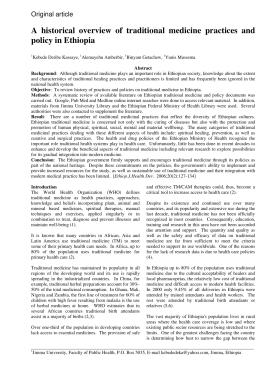A historical overview of traditional medicine practices and policy in Ethiopia
A historical overview of traditional medicine practices and policy in Ethiopia
The World Health Organization (WHO) defines traditional medicine as health practices, approaches, knowledge and beliefs incorporating plant, animal and mineral based medicines, spiritual therapies, manual techniques and exercises, applied singularly or in combination to treat, diagnose and prevent illnesses and maintain well-being.
It is known that many countries in African, Asia and Latin America use traditional medicine (TM) to meet some of their primary health care needs. In Africa, up to 80% of the population uses traditional medicine for primary health care.
Traditional medicine has maintained its popularity in all regions of the developing world and its use is rapidly spreading in the industrialized countries. In China, for example, traditional herbal preparations account for 30%-50% of the total medicinal consumption. In Ghana, Mali, Nigeria and Zambia, the first line of treatment for 60% of children with high fever resulting from malaria is the use of herbal medicines at home. WHO estimates that in several African countries traditional birth attendants assist in a majority of births.

